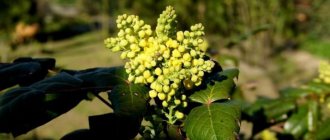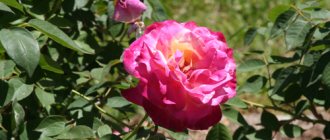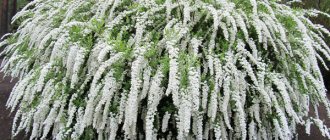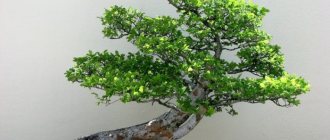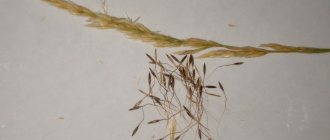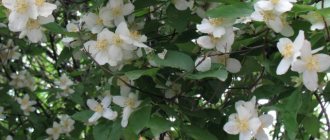The perennial plant sapling (Eupatorium) is a member of the Asteraceae or Asteraceae family. This plant comes from North America, then it spread throughout Europe, Asia, and can also be found in the tropical regions of Africa. This genus includes more than 120 species that have been described, and there are also approximately 200 species that have an uncertain status. Experts believe that the Russian name poskonnik is derived from the word “poskon”; this is how the male hemp plant is called; the fact is that these 2 plants are somewhat similar in appearance. The scientific name of the genus was given to it in honor of the Pontic king Mithridates Eupator, who used one of the species of sapwood as an antidote.
Description
Purple sapling (lat. Eupatorium purpureum) is a perennial herbaceous shrub. It belongs to the Asteraceae, or Asteraceae, family. Found in the wild in Europe, Asia, and America. “Poskonnik” received its modern name for its resemblance to hemp, which in Rus' was previously called “poskon”.
Purple sapling - a modest handsome man
The main parameters of purple sapling are presented in the table:
| Parameter | Meaning |
| Russian names-synonyms | Hemp, turnip, horse's mane, sedach, shaposhnik |
| Plant type | Herbaceous perennial shrub |
| General form | Dense, heavily leafy, medium-spreading bush up to 2 m high and up to 1 m wide, over time can form continuous thickets |
| Escapes | Erect, non-branching, powerful, red-violet |
| Leaves | Opposite or whorled, elongated spear-shaped, slightly boat-curved, bright green with reddish-purple veins, edge of the plate slightly serrated, petiole short |
| Root system | Well developed rhizome |
| Flowers | Pink-lilac, small, with a tubular corolla, collected in inflorescences-baskets, forming voluminous caps up to 30 cm in diameter at the ends of the shoots |
| Fruit | Small, dark, rough, located in seed pods |
Flowering period
Purple sapling blooms in mid-summer. At this time, the plant emits a subtle, pleasant aroma that attracts many butterflies and other insects. Flowering lasts about 7 weeks and usually ends in September, although individual specimens may continue to bloom until the first frost.
Types and varieties of saplings with photos and descriptions
Hemp sapling (Eupatorium cannabinus)
In nature, this species is found almost throughout Europe, and it prefers to grow in streams, swamps and wet meadows. The height of its erect stem can vary from 0.2 to 1 meter. Short-petioled, slightly pubescent leaf blades with serrate edges have a palmate-separated shape, and they contain from 3 to 5 segments. Pink baskets are collected in apical corymbose-paniculate inflorescences. The most popular decorative forms are:
- Plenum (Flore Pleno). The height of the bush is about 1.6 m. During prolonged flowering, the plant is decorated with terry baskets.
- Variegatum. The height of the bushes is about 0.75 m. An uneven white border runs along the edge of the foliage, and the bush is also decorated with deep pink flowers.
- Album. The color of the inflorescences is white.
Wrinkled sapling (Eupatorium rugosa)
Unlike other types, this sill has opposite oval-shaped leaf plates, as well as a jagged edge. The color of the inflorescences is white. The best varieties of this type are:
- Chocolet. This variety is highly resistant to frost. Glossy leaf plates of a bronze-brown hue have a purple tint when opening. The inflorescences contain small white flowers.
- Braunlaub. The height of the plant is about 150 cm. The buds and young foliage are brown in color.
Purple sapling (Eupatorium purpureum)
This rhizomatous perennial plant is native to North America; it reaches a height of up to one and a half meters. Straight shoots are colored greenish-blue. Whorled hairy leaf plates, oval-lanceolate in shape, pointed towards the apex, their edges are jagged. Corymbose inflorescences, reaching 0.2 m in diameter, consist of small baskets, the color of which can vary from lilac-purple to pinkish. The best varieties of this type:
- Little Ed. The height of the compact bushes is about 100 cm, they are decorated with wine-pink inflorescences.
- Little Joe. On bushes a meter high, inflorescences grow, consisting of small flowers of a smoky pink hue.
Spotted sapling (Eupatorium maculatum)
This North American plant in nature prefers to grow in forests, thickets and meadows of the coastal zone. The height of the powerful bush is about 1.8 m; the whorled leaf plates have an elongated shape. The color of the inflorescences is lilac. The following varieties are most popular among gardeners:
- Album. The two-meter bush is decorated with white inflorescences with a grayish tint.
- Atropurpureum. The dark red stems reach a height of up to 2 m. The color of the flowers is violet-pink.
- Barterd Bride. Snow-white inflorescences adorn the plant, reaching a height of up to 240 cm.
- Gateway. The height of the red stems is about 150 cm. The dense dome-shaped inflorescences include mauve-colored flowers.
- Big Umbrellas. The height of the bush is about 1.8 m. Large caps consisting of pinkish-gray inflorescences form on the red stems.
- Caryn. The two-meter bushes are decorated with light lavender inflorescences.
- Phantom. This hybrid has dark stems that reach less than a meter in height. The color of the flowers is bluish-lilac.
- Purple Bash. The stems of the one and a half meter bushes are dark red. The mauve inflorescences resemble the Gateway variety in appearance, but are smaller in size.
Growing from seeds
In the wild, purple sapling reproduces by self-sowing, which is why the plant eventually forms dense thickets. The seed method can also be used for growing seedlings and then planting them on the site. However, if you plant sapling seeds directly in open ground, the grown plants will bloom only in the 3rd year. Therefore, it is recommended to use the seedling method.
Seed preparation
Before sowing planting material, it must be stratified for 1 month. It is better to do this in February-March. Purple sapling seeds are mixed with sand and placed in the refrigerator for this period, where they are stored in a vegetable tray at a temperature of about + 2 °C.
When to plant
At the end of stratification, the seeds of purple sapling are sown in containers filled with special soil. The optimal time for this is the last ten days of March. By this time, you need to prepare wide and shallow containers for growing seedlings, and also stock up on soil, purchasing it in a store or mixing sand, peat and turf soil in equal proportions yourself.
It is very convenient to use special cups or cassettes for growing seedlings
Important! Before use, the soil must be disinfected by spilling it with a solution of potassium permanganate or calcining it in the oven for at least 0.5 hours at a temperature of + 200 ° C.
How to grow seedlings
Stratified seeds of purple sapling are kept for 1 day in a weak solution of potassium permanganate, and then planted in containers filled with soil without being buried. The planting material is evenly distributed over the surface, lightly pressed down or sprinkled with a thin layer of soil, and then moistened with water from a spray bottle. The container is covered with glass or film and then placed in a warm, dark place.
Important! Periodically, the cover must be removed to ventilate the soil. In case of drying out, it is moistened with warm, settled water.
It takes 2 to 3 weeks for purpurea seeds to germinate
Purple sapling seeds germinate in 2-3 weeks. After the first shoots appear, the cover should be removed and the container moved to a well-lit place. After 2 pairs of permanent leaves appear, the seedlings are picked into separate pots. It will remain there until the end of May; it is at this time that it is transplanted into open ground. Approximately 10-14 days before this, the containers begin to be exposed to air, and the holding time is increased each time. This is how plants are hardened.
Important! The soil temperature at the time of transplanting seedlings should not be lower than + 8-10 ° C, there should be no threat of return frosts.
How to beautifully plant gladioli flowers in the garden (with photo)
In any landscape design, flowers must be used as one of the main decorative elements. They have bright colors, long flowering periods and fill the air with a pleasant fragrance. Thanks to these properties, flowers can be planted in almost any area. Special places are allocated for flower beds, which can be located in front of the house, along fences and paths, near ponds, or they are laid out against the background of a lawn. You can create a flower garden of any size and shape, it all depends on the size of the plot and the imagination of its owner. If you choose the right flowers and place them in the flower garden, they can delight the eye with their blooms from early spring to late autumn.
There are two types of flowers: annual and perennial. Sometimes flowers from different groups are grown in one flower garden. Before you start creating a flower garden, you need to think about how it will fit in with the rest of the landscape design elements.
When choosing a location for a flower garden, several factors must be taken into account.
First you need to select the main vantage points from where the flower garden will be clearly visible. Such points include the entrance to the site, house windows, gazebos, paths, garden benches. You can plant a flower garden in such a place that it can be seen from almost anywhere on the site. But at the same time, it is necessary to ensure that the magnificent flower garden does not block the rest of the picturesque corners of the garden.
Next, you need to decide what type of flower garden you are going to create in each specific area of the site. Each species has a specific purpose, which determines the location of the planting, as well as the choice of plants for the flower garden.
Gladioli are the most beautiful in group plantings. In flower beds they are usually planted in the background or in the center. Lower plants are planted in front of them to hide the soil and lower part. Often these flowers are planted along fences, which serve as a background and support for them.
Look how beautiful the gladioli flowers are in the garden in these photos:
Gladioli are combined with lower Houston ageratum, marigolds, phlox, and dahlias. Flower beds in which gladioli grow next to plants that have silvery leaves, such as wormwood, look beautiful.
Planting in open ground
Purple sapling is undemanding to growing conditions. The procedure for planting it is simple, as is its subsequent care.
How to choose a place
Purple sapling has no special preferences, it does not place high demands on the site and grows well both in the sun and in partial shade. The soil is preferably fertile and loose; this plant does not feel comfortable on clay and sand. Acidity should be close to neutral.
How to prepare the soil
Before planting young seedlings of the purple sapling, the soil on the site should be dug up, cleared of debris and old grass, and at the same time add compost (3-5 kg per 1 sq. m). Planting holes are prepared based on the size of the seedling's root system. When planting in groups, the intervals between neighboring plants should be at least 0.6 m. The seedlings are removed from the cup along with a lump of earth on the roots and carefully placed in a hole, sprinkled with earth and compacted. After this, the young seedling must be watered abundantly.
Peat cups eliminate the need to remove the plant before planting
Important! If you immediately use peat cups for growing seedlings, then no picking is done, and planting in open ground is done together with the container, without removing the plant.
Watering
Purple sapling loves moist soil, but excess water is harmful to it. Excessive moisture can lead to rotting of the roots and death of the plant, so watering is required, although regular, but moderate. Newly planted seedlings, as well as separated parts of rhizomes that are in the process of rooting, need additional watering. At such times, you need to be especially careful to ensure that the soil does not dry out.
Feeding
Frequent regular fertilizing of purple saplings is not required. In early spring, nitrogen fertilizers are applied, stimulating the growth of shoots, and during the period of budding and flowering, you can use any complexes for flowering shrubs, for example, Kemira-Universal.
Do I need to tie it up?
The stems of the purple sapling are strong and rigid; they can easily withstand the weight of a large, cap-shaped inflorescence. The bushes themselves are also quite dense and resist the wind well. Therefore, there is no need to tie them up.
How to care
Caring for window sills in open ground is not difficult. Like any plant, it needs feeding, watering, weeding, loosening, pruning, and protection from insects. The crop is distinguished by its high growth, so you should provide for the installation of a support or plant the flower near a fence or buildings so that there are no through winds that could break the stems. The stems are not pruned, but in order to preserve decorativeness and prevent self-seeding, faded inflorescences are cut off.
The plant is cold-resistant, so there is no need to cover it for the winter - it is enough to cut off the above-ground part at the end of autumn.
Watering, fertilizing
As a moisture-loving crop, the flower needs to be watered regularly, depending on the weather conditions. It is important to prevent the soil from drying out and flooding. Loosening will eliminate the formation of crust on the surface and the growth of weeds. Mulch made from grass, leaves, hay will reduce moisture loss and inhibit the growth of weeds; crushed dry branches, small pebbles, pine cones, and decorative bark can be used to give a decorative look. Humus and compost as mulch will become a source of additional nutrition.
The choice of fertilizer for the sill is influenced by the period of its application. In the spring, when feeding for the first time, it is recommended to use complexes with a prevailing nitrogen content - it stimulates the growth of green mass, which is important for an ornamental plant. Watering with mullein infusion and adding humus to the soil gives a good effect.
They feed the second time in June, enriching the soil with macro- and microelements necessary for the formation of buds and abundant flowering. Complex fertilizers for flowering crops are suitable - they indicate the composition and exact dosage. You can add phosphorus, potassium, magnesium, nitrogen separately, following the instructions.
The next feeding is carried out during the budding period, using complexes with potassium: potassium salt, potassium sulfate, nitrate, potassium chloride.
Nitrogen is not needed during this period - the plant’s forces should be directed to the formation and development of buds, and nitrogen causes foliage to grow.
In mid-October, phosphorus-potassium complexes with a minimal content (or complete absence) of nitrogen are introduced to support the immunity of the perennial before the winter cold. They can be used dry or in solution. Humus and compost poured under each bush will protect the roots in frosts and replenish the soil with organic matter.
Pests, diseases
The culture has good immunity and is not susceptible to pests or infections. It can be harmed by the larvae of moths, insects, beetles - the so-called miners, which eat passages in the stems and leaves. Pruning the affected parts and treating the entire plant with an insecticide helps.
More details about window sill care in the video:
Reproduction methods
Purple sapling can be propagated both by seeds and vegetatively. It is preferable to use the second method, since in this case all varietal characteristics of the plant are guaranteed to be preserved. In addition, when using vegetative methods, a full-fledged flowering bush can be obtained much earlier.
Dividing the bush
This propagation method is suitable for purple sapling bushes that are at least 5 years old. Its essence is as follows.
- In early spring or autumn, all shoots of the bush are cut off at a height of 0.2-0.3 m.
- The rhizome is dug out of the ground.
- Using a sharp bayonet shovel or an ax, the rhizomes are divided into parts containing several shoots with their own lobe.
- The sections are treated with a solution of potassium permanganate or brilliant green.
- The delenki are immediately planted in pre-prepared pits.
Each division must have at least 3 growth points
Important! Next time, it will be possible to divide the purple sapling bush only when it reaches the age of 5 years or more.
Young shoots
This method is similar to the previous one. For propagation, young shoots of purple sapling with a height of at least 5 cm are used, which are cut off along with the root. For growing, they are placed in special containers or boxes filled with soil for seedlings. The plants are kept in such comfortable conditions for about a month, providing them with good care and regular moderate watering. Then the strengthened seedlings of purple sapling are transplanted to a permanent place in open ground.
Cuttings
The sapling can be propagated by green cuttings, which are harvested in June. They are cut from annual shoots, the length of each should be at least 10-15 cm. Green cuttings are rooted in containers filled with a mixture of peat and sand. Planting is carried out obliquely, the depth should be about 5 cm.
Rooted cuttings should be covered with a glass jar or cut plastic bottle
A film cover must be mounted on top, or each cutting must be covered with a cut plastic bottle or glass jar. It will take about 1 month to form its own root system, after which the seedlings are transferred to a permanent place.
Important! During the entire rooting period, the cuttings of purple saplings must be ventilated and the soil substrate must be moistened, preventing it from drying out.
Tips for caring for window sills
- A winter-hardy plant does not need shelter during cold weather. It tolerates any frost well.
- Requires a lot of light. If it does not receive it in full, it may not begin to flower.
- She loves a lot of water and will thank you for abundant watering with gorgeous blooms.
- If you have sandy soil, then for the bush to grow, you need to add compost to the ground before planting. Otherwise, the plant may die. The most favorable environment for it is loose, humus-rich soil.
- An unpretentious plant still requires three feedings: in spring, in June, during the formation of buds.
It’s as if the white airy feathers of Cohosh pierce thunderclouds in the form of voluminous inflorescences of Spotted Pokonnik. Another successful combination.
The shrub does not negatively affect nearby flowers, so it can be combined with any flowers, for example: astilbe, echinacea, various cereals.
Photo of a window sill in landscape design
A lush purple sapling bush can be a good accent in a garden composition. In addition to individual plantings, you can also use group ones, for example, to create a hedge or a color background for smaller plants.
A two-level hedge provides excellent protection from the wind.
Purple sapling looks great as part of a mixborder
Purple sapling bushes can decorate a wrought-iron fence
Sill bushes harmoniously combine with water bodies
In combined flower beds, the window sill is planted in the background; it serves as a backdrop for other, smaller plants
Features of the window sill
Posonnik is a rhizomatous annual or perennial, which is represented by herbaceous plants and subshrubs. Straight shoots are decorated with opposite foliage, which is less often whorled or alternately arranged. Palmate-lobed or pinnate leaf plates have a solid or serrated edge, they are petiolate and sessile, and their shape is oblong, rhombic, ovoid, elliptical, linear or lanceolate. The surface of the foliage can be rough, smooth, or pubescent. The baskets consist of small, tubular-shaped flowers that can be colored pink, bluish-purple, purple or white. The baskets are part of complex paniculate, racemose or corymbose inflorescences. The fruit is an achene.
Unpretentious plants for the garden Poskonnik. Website "Garden World"
Use in folk medicine
Purple sapling is included in the list of medicinal plants in Russia. It has long been used in folk medicine as an anti-inflammatory, expectorant, and diuretic. Currently, its medicinal value has been greatly lost, since much more effective drugs have been synthesized. It should also be taken into account that all parts of the purple sapling contain toxic substances - alkaloids, therefore any homemade products based on this plant should be used with caution and only after consulting a doctor.
Plant characteristics
Sill planting and care in open ground
The flowers of these plants can have different colors. They can range in color from pink to purple. The shoots are powerful and erect. The growth of perennial sapling reaches 1-2.5 m. This plant has dark green leaves that are large in size and elongated in shape. The flowers are small, collected in inflorescences, which are shaped like a hat. Flowering begins in mid-summer and ends in autumn.
Interesting. Purple sapling has a complex and intense aroma, in which you can detect various shades.
How to choose the right window sill when purchasing
To purchase a window sill, a specialized garden store is best suited; this will provide a certain guarantee of the quality of the planting material.
Rules for choosing sapling rhizomes
The product being sold must be in transparent packaging so that it is possible to evaluate its quality according to the following criteria:
- There is no mold or rot on the rhizome.
- The roots are intact, without mechanical damage.
- The rhizome is hard, elastic, and at the same time unbreakable.
- When purchased in spring, swollen buds are visible.
Do not hesitate to carefully examine and touch the selected rhizome; this determines whether the plant will take root in your area.
Selection of seedlings
Sapling seedlings are usually sold in individual pots. Carefully examine the condition of the plant:
- The leaf is strong, looking up cheerfully. Softness and lethargy indicate a lack of watering.
- The earthen lump is moist, not overdried.
- The roots are hidden in the soil.
If the roots stick out from the container, you should not purchase such seedlings; they are unlikely to take root.
Possible problems in growing
Poskonnik is a plant that has strong immunity to various diseases and has special endurance, which helps to survive attacks from pests.
Problems with leaves
If the edges of the leaves begin to dry out, it means that the plant does not have enough moisture. The leaves can also be affected by pests. They get rid of them by removing damaged leaves.
Pests
Pests do not really like to attack the sable flower. The only threat comes from the leaf miner, which chews tunnels in the leaves. To get rid of parasites, damaged foliage and shoots need to be cut from the bushes. This will not harm the plant, since it tends to recover quickly.
Important! If the area is extensively affected, it should be treated with insecticides.
Diseases
The plant is not susceptible to any diseases, with the exception of infrequent damage from pests.
Signs of improper care
Limp and dull leaves are a sign of improper watering. If flowering does not begin on time, it means that the plant does not receive enough sunlight.
Features of cultivation and care
Looking at the photo of the window sill, it becomes clear that it retains its decorative qualities throughout the entire growing season. The plant looks great both in a flowerbed and cut in a vase. This perennial is easy to care for. The plant is unpretentious, quickly takes root and adapts.
Resistance to pests and diseases
The sapling will not bother you with its diseases; it has good resistance against them.
It is also not susceptible to pest attacks.
The only pest that can appear on this perennial is the leaf miner.
It settles inside the leaf, boring out peculiar “tunnels”.
The miner can be detected by the characteristic pattern on the surface of the leaves.
The most effective way to fight is to collect and burn such foliage.
If the affected area is large, use an insecticide such as Actellik.

